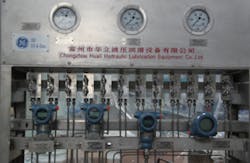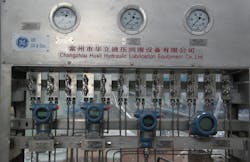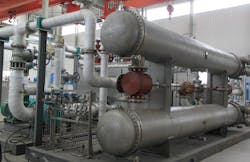Case Study: Temperature instrument improves natural gas compressor uptime
Natural gas production sites and pipelines are being installed all over the globe. The most active countries in terms of pipelines planned and under construction are China, India and Australia. In China, the majority of activity is connected to China National Petroleum Corp. (CNPC), the country’s largest oil and gas producer and supplier. The company is concentrating on coordinating domestic and international resources and markets as part of China’s energy security.
CNPC’s most significant natural gas transmission project is the West-East Gas Pipeline Project (WEPP). WEEP is broken into five phases for pipelines that travel along varied terrains such as plateaus, mountains, deserts, and rivers to connect the Tarim Basin in Xinjiang Autonomous Region and Turkmenistan with the Yangtze Delta and Pearl Delta regions. By project completion, the pipeline network is expected to give 95 percent of China’s cities access to natural gas. Experts estimated that the gas transported will reduce an expected 130 million tons of carbon dioxide emissions, along with 2.46 million tons of other harmful emissions.
READ ALSO: RTDs vs. Thermocouples—Which technology should you use for your process application?
The WEPP I pipeline stretches 2,485 miles (4,000 km) across 15 provinces and transports natural gas from Xinjiang Province to Yangtze River Delta. The area is a harsh environment with rugged terrain and extreme temperatures. It is an environment detrimental to equipment, more specifically, remote-automated compressor stations used for boosting pressure to keep the gas moving through the pipeline.
A high probability of equipment breakdown for the compressors was something the provider, General Electric (GE) Oil and Gas, had to overcome. The cost of compressor repairs can be staggering. Even worse, the entire station and its workers are at risk from failures that can impact safety and profitability. Breakdowns can be caused when the hydraulic fluid in compressors goes beyond operating temperature practical limits—both high and low. To find a solution, GE partnered with Huali Hydraulic Lubrication Equipment Company (HHLEC), Ltd. HHLEC is an Original Equipment Manufacturer (OEM) of Emerson Process Management located in Changzhou, Jiangsu Province.
Temperature monitoring essential in uninviting environment
HHLEC had to find a way to meet the challenges caused by an altitude of 9,842 feet (3,000 meters), where temperatures reach -40 F (-40 C). If the temperature exceeds the limit, the lube oil quality is impacted. If the temperature is too high, the lube oil may damage the compressor. HHLEC recommended adding temperature sensors and transmitters to monitor the temperature in the system. If oil temperature exceeds the limit, an alarm will be sent by the transmitter.
However, not all temperature measurement equipment is suited for this type of environment. "I used some locally manufactured sensors, and they would break in a harsh environment," says Mr. Yu, chief engineer, HHLEC, Ltd. Further, LCD meters were needed that could withstand the cold. "I needed an LCD meter which can stand -40 C, as our equipment is installed in the desert and high altitude, which will expose the equipment to low temperature," says Mr. Za, design engineer, HHLEC Ltd.
How the temperature measurement equipment responded to electromagnetic fields was also important. "I need a temperature product with good electromagnetic immunity," says Mr. Zhang, design engineer, HHLEC, Ltd. The HHLEC Engineering Team recommended Emerson Process Management’s Rosemount 3144P Temperature Transmitters with dual-compartment housing and Rosemount 0065 Temperature Sensors to provide critical temperature monitoring at ports of the lubrication equipment.
Product stability helps save on maintenance costs
But what about the need to control maintenance costs? Sensor inefficiency and drift can be very expensive since it creates a need for recalibration by a service technician and can raise maintenance costs considerably. "It is a very high cost if we travel to a site for maintenance of the measurement products in our lubrication equipment," says Mr. Wu, maintenance engineer, HHLEC, Ltd. The answer was using transmitter-sensor matching and calibration with products from a single manufacturer designed to work in unison.
Transmitter-sensor matching is achieved by utilizing the Callendar-Van Dusen (CVD) equation and entering the CVD constants into the transmitter, thus matching the transmitter to that specific sensor. The calculations indicated the best match was a Rosemount 3144P Transmitter and Rosemount 0065 Sensor, which offered high accuracy and long-term stability, even in the harsh environment. Based on this conclusion, HHLEC installed and commissioned 20 units of the Rosemount 3144P Transmitter and Rosemount 0065 Sensor.
The Rosemount 3144P Transmitter is designed for harsh environmental factors that can make other transmitters susceptible to failure. The Rosemount 3144P ensures calibration integrity and improves measurement point accuracy. A Rosemount 0065 Sensor with high standard welding construction and manufacturing process will provide long-term stability and life.
The solution of using Rosemount products from Emerson Process Management fulfilled GE’s needs for reliability in a harsh environment and also brought long-term stability. Safety levels were also improved with the Rosemount 3144P’s SIL2 certification. Maintenance costs were lowered as well, enabling the station to save 30 percent annually on maintenance, with fewer sensor replacements and fewer visits by service technicians.
GE extended its contract with HHLEC to work on other parts of the WEPP project because of the positive experience and outcome. Since the start of 2014, an additional 160 Rosemount transmitters and sensors have already been purchased for the project.
Sarah Lee is responsible for the Rosemount temperature product line in Emerson’s Product Marketing Group in China. Ms. Lee has deep insights of China’s customers and market and rich knowledge of temperature product and solutions.
Debby Wadsworth is the marketing campaign manager with Emerson Process Management’s Rosemount Temperature Division. Ms. Wadsworth can be reached at 952-949-7310 or [email protected].




